I love cooking, and when I cook I want to make sure that I keep as many nutrients as possible. Food contains a multitude of powerful nutrients that protect and maintain our health, but do you know how to cook your food to get the maximum benefit from it?
We’ve all heard of carbohydrates fats and protein, but food contains many more nutrients such as vitamins, minerals and phytochemicals that are vital for our health.
Now some people would say eat your vegetables raw, but if you’re like me you’d rather have them cooked, so it pays to know how to cook them to preserve the most nutrients.
Did you know that cooking can actually increase the goodness in some ingredients!
So here are our Top Ten Tips for getting the most from your food
1. Reduce the water used for boiling
Some vitamins which are very powerful in protecting your health are water soluble. This means they leach out in hot water. So for example if you currently cover your greens in water and boil them, then throw away the water, you will only keep around 55% of the vitamin C content of a raw green veg.
So boiling is not ideal when it comes to water soluble vitamins!
However if you just reduce the amount of water used you will keep around 60% of the vitamin C content, this is because if you don’t submerge the veg completely more of the water soluble vitamins stay in the greens. But it's still not as good as it could be.
2. 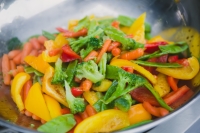 Stir fry
Stir fry
Taking this a step further if you stir fry the greens you will keep around 85% of the vitamin C, this is because the water soluble vitamins don’t leach out as much into the oil used for stir frying. Now we’re getting somewhere!
3. Steam as much as possible
Steaming is a great way to retain the water soluble vitamin content of your veg if you want it to be tenderer than if it was stir fried. For example you can steam broccoli until it is tender and still keep 85% of the vitamin C. Great!
4. Use the cooking water
Using the cooking liquor will also maximise the water soluble vitamin content, if you use the water you boiled your greens in you will retain much more of the vitamin C, and other water soluble vitamin content. So save that water and add it to your gravy or sauce.
5. 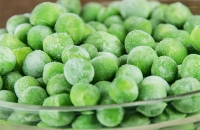 Use frozen veg
Use frozen veg
Frozen peas for example only need to be reheated as they are blanched prior to freezing very soon after they are picked. Reheating frozen peas will retain 100% of some water soluble vitamins! Wow, what a great staple to have in the freezer.
6. 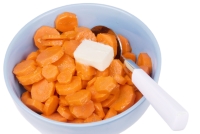 Always butter your veg!
Always butter your veg!
Remember what grandma always did with veg?
Just as some vitamins are water soluble some are fat soluble, so for example when you have cooked a carrot the main benefit is the beta carotene content, (which we convert to vitamin A), however this is a fat soluble nutrient so needs to be eaten with some fat to maximise your body’s use of the goodness.
Most veg has fat soluble vitamin content so make free with the oil, butter and fat from the roast in the gravy when serving veg.
7. 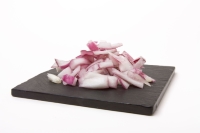 Chop in advance
Chop in advance
The powerful health giving properties of onions, garlic and carrots are well known, what is less well known is that how they are prepared and served greatly affects your ability to absorb these health benefits.
The active ingredients in garlic and onions are very easily destroyed by heat, however scientists have observed that by chopping and mixing either garlic or onions, 10 minutes before cooking potentises the active ingredients and protects them against the effects of heat. A thumbs up to the restaurant practice of preparing these veg in advance.
The active ingredients in carrots (carotenes) are very tightly bound up in the structure of the plant so both chopping, cooking and chewing carrots will enhance your absorption of them.
In summary, chopping, mixing, cooking and chewing well will benefit your health when it comes to onions, garlic and carrots!
8. Maximise protection
There are two new and contrasting reasons to be aware of in your cooking methods.
Recently you will have seen many claims being made for super foods like blueberries, the reasons for these claims such as ‘blueberries are a powerful antioxidant’, is the phytochemical content. Phytochemicals are the chemicals that plants use to protect themselves against disease.
Plants use phytochemicals to protect themselves from bacteria, fungi, viruses and cell damage with things like ‘flavonoids’. Research has shown that these same chemicals can prove equally beneficial to us, helping in areas like cancer, heart disease and diabetes prevention.
The phytochemical content of some veg and fruit is greatly reduced by cooking (much more so than vitamins and minerals), however the phytochemical content of carrots and tomatoes is greatly enhanced by cooking!
What about cooking meat?
9. Use the juices when roasting
Vitamins and minerals leach out of the Sunday roast during cooking so to get them back use the juices and as much of the fat as you would like for the gravy.
With roast pork for example including the juices in the gravy will give you 30% more thiamin (B1) and phosphorus which are very powerful micronutrients for our health.
10. 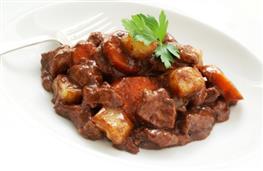 Make one pot meals
Make one pot meals
One of the best ways to ensue you’re getting the most out of your meat and vegetables, is to make one pot meals. Casseroles, stews, soups and hot pots are fantastic at holding the nutrients in with minimum losses.
A quick recap - The best ways to cook your veg:
Quickly stir frying or steaming green veg, chopping onions, carrots and garlic 10 minutes before cooking, and cooking carrots and tomatoes for longer, will afford you not only the amazing benefits of the vitamins and minerals, but also the protective qualities of phytochemicals.
Your easy guide to fat soluble and water soluble vitamins:
Fat Soluble
Vitamins: A, E, K1, K2, D and vitamin A
Water Soluble
Vitamins: C, B12, B6, Biotin (B7), Choline, Folate (B9), Niacin (B3), Pantothenic acid (B5), Riboflavin (B2), Thiamin (B1)
As you can see the majority of vitamins are water soluble, but how can you know which foods have the most of which vitamins?
Simple at www.checkyourfood.com all ingredients are displayed with all of the vitamins present. It also lists the top 6 vitamins for you to see at a glance what it has the most of.
Happy cooking!
Sources –
The United States Department of Agriculture nutrient retention in cooking information,
The Linus Pauling Institute Micronutrient Center.
Matt Wright
Director - Nutrient expert, researcher & data miner
I am responsible for the scientific research and data oversight at the CheckYourFood Group. A great journey of discovery for me as I uncover the myriad of goodness that natural food contains and facilitate others to promote health and wellbeing.
 FB
Twitter
G+
Instagram
Pintrest
FB
Twitter
G+
Instagram
Pintrest

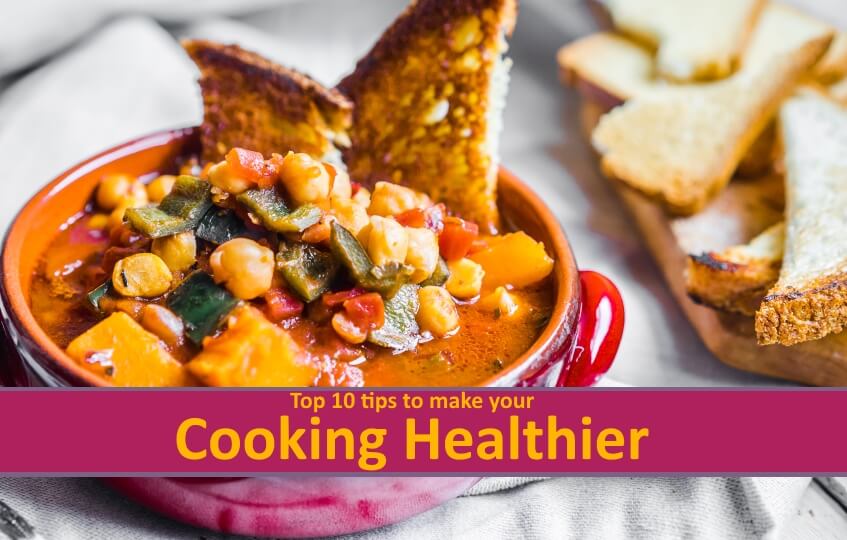
 Stir fry
Stir fry  Use frozen veg
Use frozen veg Always butter your veg!
Always butter your veg! Chop in advance
Chop in advance Make one pot meals
Make one pot meals